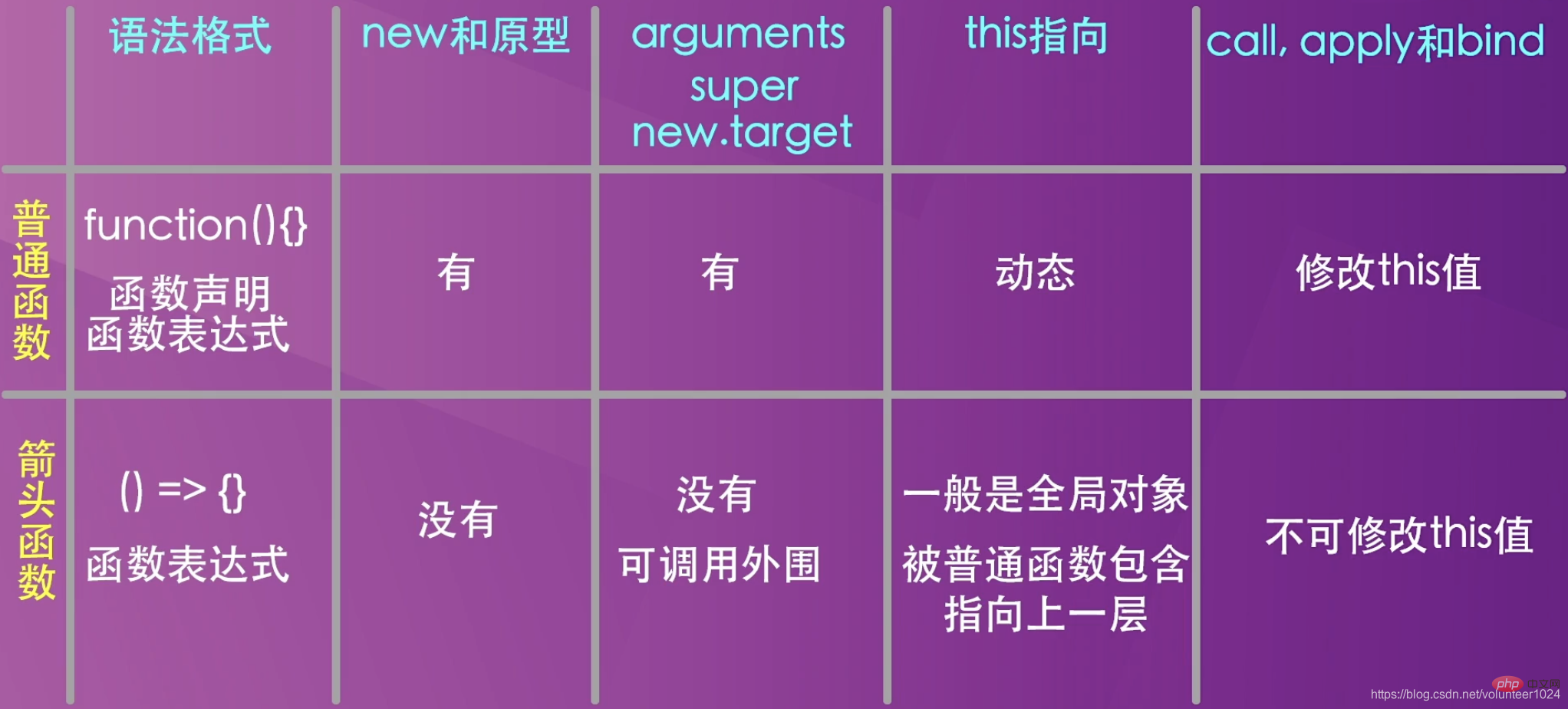
This article brings you relevant knowledge about javascript, which mainly introduces issues related to the application of arrow functions. Arrow function expressions are more suitable for places where anonymous functions are originally needed, and It cannot be used as a constructor. Let's take a look at it. I hope it will be helpful to everyone.

[Related recommendations: javascript video tutorial, web front-end】
The syntax of arrow function expressions is more concise than function expressions, and does not have its own this, arguments, super or new.target. Arrow function expressions are more suitable where an anonymous function would otherwise be required, and it cannot be used as a constructor. ---- MDN
(param1, param2, …, paramN) => { statements }
(param1, param2, …, paramN) => expression
//相当于:(param1, param2, …, paramN) =>{ return expression; }
// 当只有一个参数时,圆括号是可选的:
(singleParam) => { statements }
singleParam => { statements }
// 没有参数的函数应该写成一对圆括号。
() => { statements }let add1 = (num1, num2) => {
num1 + num2
};
let add2 = (num1, num2) => {
return num1 + num2
};
let add3 = (num1, num2) => (num1 + num2);
let add4 = (num1, num2) => num1 + num2;
console.log(add1(2, 3)); // undefined
console.log(add2(2, 3)); // 5
console.log(add3(2, 3)); // 5
console.log(add4(2, 3)); // 5//加括号的函数体返回对象字面量表达式:
let func = () => ({foo: 'bar'})
console.log(func()); // {foo: 'bar'}
//支持剩余参数和默认参数
(param1, param2, ...rest) => { statements }
(param1 = defaultValue1, param2, …, paramN = defaultValueN) => {
statements }
//同样支持参数列表解构
let f = ([a, b] = [1, 2], {x: c} = {x: a + b}) => a + b + c;
f(); // 6
why?The syntax is more concise, and this is more in line with expectations
If the function logic is quite complex, named functions should be used
// bad[1, 2, 3].map(function (x) {
const y = x + 1;
return x * y;});// good[1, 2, 3].map((x) => {
const y = x + 1;
return x * y;});// bad
[1, 2, 3].map(number => {
const nextNumber = number + 1;
`A string containing the ${nextNumber}.`;
});
// good
[1, 2, 3].map(number => `A string containing the ${number}.`);
// good
[1, 2, 3].map((number) => {
const nextNumber = number + 1;
return `A string containing the ${nextNumber}.`;
});
// good
[1, 2, 3].map((number, index) => ({
[index]: number,
}));
// No implicit return with side effects
function foo(callback) {
const val = callback();
if (val === true) {
// Do something if callback returns true
}
}
let bool = false;
// bad
foo(() => bool = true);
// good
foo(() => {
bool = true;
});why? The beginning and end of the function are more clear
// bad['get', 'post', 'put'].map(httpMethod => Object.prototype.hasOwnProperty.call( httpMagicObjectWithAVeryLongName, httpMethod, ));// good['get', 'post', 'put'].map(httpMethod => ( Object.prototype.hasOwnProperty.call( httpMagicObjectWithAVeryLongName, httpMethod, )));
// bad[1, 2, 3].map((x) => x * x);// good[1, 2, 3].map(x => x * x);// good[1, 2, 3].map(number => (
`A long string with the ${number}. It’s so long that we don’t want it to take up space on the .map line!`));// bad[1, 2, 3].map(x => {
const y = x + 1;
return x * y;});// good[1, 2, 3].map((x) => {
const y = x + 1;
return x * y;});// badconst itemHeight = item => item.height > 256 ? item.largeSize : item.smallSize;// badconst itemHeight = (item) => item.height > 256 ? item.largeSize : item.smallSize;// goodconst itemHeight = item => (item.height > 256 ? item.largeSize : item.smallSize);// goodconst itemHeight = (item) => {
const { height, largeSize, smallSize } = item;
return height > 256 ? largeSize : smallSize;The arrow function cannot use new to create an instance of the constructor, but the ordinary function can (because the arrow function When it is created, the program will not create a construct method for it, that is, it has no construction ability and will be thrown away after use. Unlike ordinary functions that are reused, there is no need for a constructor prototype, that is, the prototype attribute will not be automatically generated)
The program will not create arguments objects for arrow functions
This in ordinary functions is dynamic, while this in arrow functions points to a tight The object that tightly wraps the arrow function (determined when defining)
The arrow function cannot change the value of this through bind, call, and apply, but it can still call these methods (just The value of this is not controlled by these methods)
[Related recommendations: javascript video tutorial, web front-end]
The above is the detailed content of Example code of ES6 arrow function practice. For more information, please follow other related articles on the PHP Chinese website!
 es6 new features
es6 new features
 What are the new features of es6
What are the new features of es6
 Linux find command usage
Linux find command usage
 Introduction to SEO diagnostic methods
Introduction to SEO diagnostic methods
 Solution to the Invalid Partition Table prompt when Windows 10 starts up
Solution to the Invalid Partition Table prompt when Windows 10 starts up
 Property management system software
Property management system software
 Install and configure vnc on ubunt
Install and configure vnc on ubunt
 js split usage
js split usage
 Use of jQuery hover() method
Use of jQuery hover() method